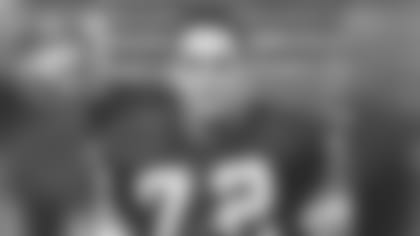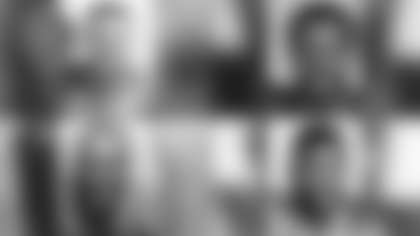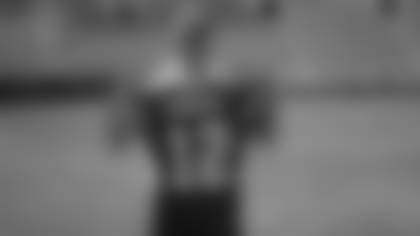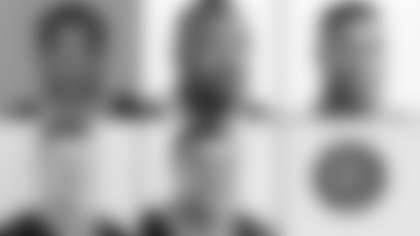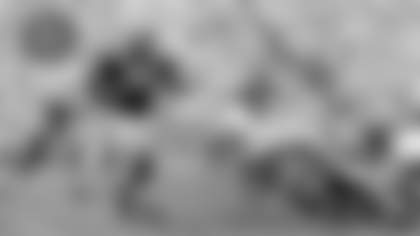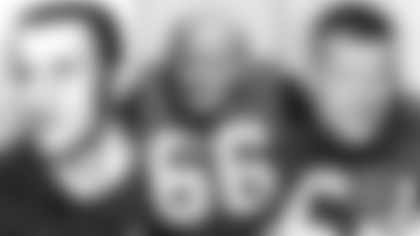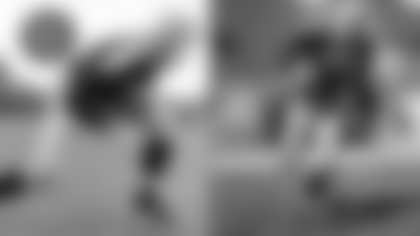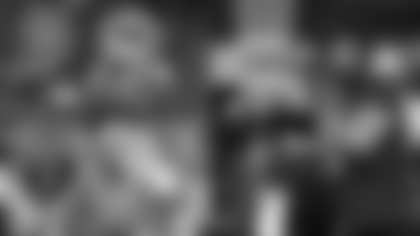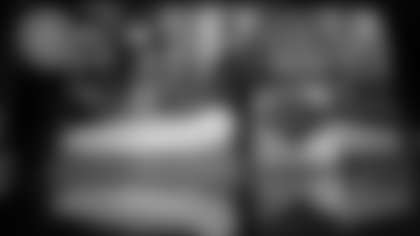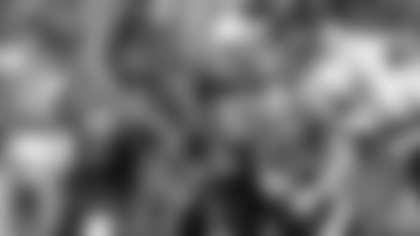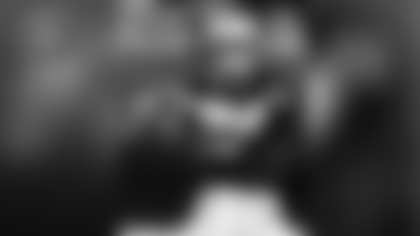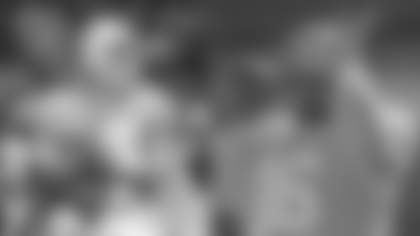Cliff Christl started gathering oral histories with former Packers and others associated with the team in 1996 and will continue to gather them as Packers historian. Excerpts from those interviews will be periodically posted at www.packers.com
Jerry Helluin, who was listed at 6-foot-2 and 272 pounds, was the Packers' starting defensive tackle opposite Dave Hanner from 1954-57. Selected as a future by the Cleveland Browns in the third round of the 1951 NFL Draft, Helluin finished his college career that year at Tulane, where he played at closer to 290 pounds and was nicknamed "The Mountain." Helluin signed with the Browns in 1952 and played in 18 games over two years, missing six games in his second season with a broken wrist. The Packers acquired Helluin from the Browns in June 1954 for a fourth-round draft choice. In 1958, Helluin injured his shoulder in the intra-squad game and missed the entire season. He returned in 1959 but was cut by Vince Lombardi on Sept. 3. In 1960, Helluin signed with the Houston Oilers of the newly formed American Football League and played in 14 games for the league's first championship team. Helluin retired before the 1961 season.
On moving from a stadium in Cleveland that could seat almost 80,000 fans to a high school field in Green Bay that seated roughly 25,000: "It was all wooden bleachers all the way around. There wasn't any steel or concrete to it. One thing about it, it was always full. It was down home, so to speak."
On the locker room at old City Stadium and other player amenities: "They weren't that bad. Even though it was a high school stadium, they were as good as anywhere else in the league. The two years I was in Cleveland, we worked out during the week at a site that was like a playground. The dressing room wasn't anything you'd brag about. We had the same situation when I was in Houston. Our facilities there were at the old Colt 45 baseball stadium. You couldn't fit the whole team in one dressing room."
On training camp in Stevens Point: "It was new territory for us. In fact, it was my first year up there and I wasn't familiar with anything. But there were little restaurants and beer joints. Entertainment was available."
On moving to Green Bay City Stadium, now Lambeau Field, in 1957: "When it was first built, it was out there by itself. It was removed from everything."
On Lisle Blackbourn, head coach of the Packers his first four seasons: "I thought he was pretty good. We got along real well. We always had good organization. Practices went along without a hitch. I came there from Cleveland. It wasn't anything like (Paul) Brown conducted. But it was on par with other programs."
On how things were different in Cleveland under Paul Brown: "After you'd been there, everything else paled in comparison."
On whether Blackbourn was a disciplinarian: "He wasn't lax on that. We didn't have a real stringent dress code, but he insisted everyone be representative when we were on the road. We all traveled with jackets. We didn't necessarily have to have ties."
On Tom Hearden, Packers' defensive coach from 1954-55: "He was well liked by the line. He had a lot of get up and go about him. He wasn't one that was laid back and would put up with any baloney. If he saw something in your technique that you weren't following through, he'd get on you. But he wasn't one that rode you all the time."
On playing next to Hanner for four years: "Dave was a real good player. Dave wasn't that big actually. Dave weighed, I guess, 250 pounds. But he handled the position like nobody's business."
On his own playing weight: "I weighed 292 when I left college. I may have been the second heaviest player in the league to Les Bingaman of the Lions, although there probably were one or two others, too. I never had any trouble moving around with it. In fact, one year, coach Blackbourn asked me if I could lose a bunch of weight. He thought I'd be better off if I lost weight. So during the offseason, I got on a diet and reported back to camp at 255. Boy, he was all excited. But after about two weeks of practice, he told me, 'You better put some weight back on. You looked better when you had a little meat on your bones.'"
On whether he put the weight back on: "It took me about three meals and I got it (he said with a laugh). It took me a little longer than that. But they always fed you good."
On Dick Afflis, a teammate and fellow lineman in 1954 who was more famous for his pro wrestling career as "Dick The Bruiser:" "He was one of them that was off the wall. That was a fella built like one of those brick things they talk about. That guy had shoulders that came down to a pinpoint of a waist. But he was a character. I remember the first time I saw him. He drove in to training camp from Reno or some place. I think he had a Cadillac convertible or something. From the waist up, he was gigantic. He had a swagger about him. He was a lot of fun to be around. He was a barrel of laughs."
On Carlton Massey, also acquired from Cleveland and one of the defensive ends in 1957: "He was quick as a cat, but small."
On Billy Bookout, a defensive back from 1955-56: "He was a wiry, little rascal. You could always count on him to stick his head in there."
On Scooter McLean, an assistant under Blackbourn and head coach in 1958: "I guess the best definition of Scooter was that he was one of the players' favorite coaches. He was an easygoing guy. He knew his football. He was very well liked by everyone."
On his shoulder injury that season: "I dislocated it. They put it in a harness and sent me home."
On Lombardi's first training camp in 1959: "It was different from the previous ones we had been in because he was real strict on conditioning. Everything had to be just right. There was a lot of repetition. If there was any flaw in your moves, your reads on an offense, you did it and did it until it was more or less burned into the brain."
On whether Lombardi was hard on him for his weight: "He was hard on everybody. He didn't ride me any more than anybody else."
On whether Lombardi gave him a reason for cutting him: "No. He just told you that you didn't fit into his plans. That was it."
On why he thought Lombardi cut him: "I was in condition. My problems were my knees."
On whether he had any other opportunities to play in 1959: "It was about a week-and-a-half and (George) Halas called me up. One of his people had gotten hurt. He called me and asked me if I would spend the season up there. He said he didn't know what the outcome would be on some of his players, but he asked me to spend the season on his reserve squad. I went up there and spent the rest of the season there."
On whether Halas picked his brain about Lombardi and the Packers: "Oh yeah. He'd ask me to give a rundown on individual personnel. What they favored in situations and games."
On joining the Oilers in 1960: "Lou Rymkus (Houston's head coach) was my line coach in Green Bay. I had first met Rymkus in Cleveland (where he had played for six years). Lou was the one coach who stuck with me more than any. Lou was the tackle coach and I got to be real friendly with Lou. Then, when he coached the Oilers that was like a hometown reunion for me."
On Rymkus' strengths as the Packers' line coach under Blackbourn: "Lou was one of those coaches all the players liked. He was a fella who knew when to joke with you. Of course, you didn't have any problem knowing when he was serious. But he had a sense of humor."
On his salary: "For the time we put in, (just) the duration of the season, it wasn't bad money. But you had to supplement your income. I worked for a trucking company in Louisiana. During the offseason, I'd go around and show Packer highlight films. My top salary was at Houston, $10,000. In Green Bay, my top was $8,500, I started in 1954 at $5,800, I think."
Helluin died in 2017 at age 88. The excerpts here were taken from interviews conducted in 2001 and 2003.



